

Wholesale Soap Making Supplies and Candle Making Supplies - WholesaleSuppliesPlus. Soap Making for Dummies. *Soap Making for Dummies*By: AFarmer01 November 2004 One of the things I have always wanted to do is learn how to make my own soap.
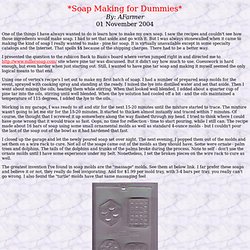
I saw the recipes and couldn't see how those ingredients would make soap. I had to set that aside and go with it. But I was always stonewalled when it came to making the kind of soap I really wanted to make - pine tar soap. It is virtually unavailable except in some specialty catalogs and the Internet. I presented the question to the rubicon Back to Basics board where vertex jumped right in and directed me to site where pine tar was discussed. Using one of vertex's recipe's I set out to make my first batch of soap. Working in my garage, I was ready to sit and stir for the next 15-20 minutes until the mixture started to trace.
I closed up the garage and let the newly poured soap set over night. The greatest invention I've found in soap molds are the "massage" molds. 1/4 cup Lye 6 oz distilled water 1 cup. Mix the lye in the water and set aside. 19th Century Seminole Men`s Clothing ~ Buckskin Leggings. Buckskin was the Southeastern Indians' plastic: cheap, readily available, and throwaway.

The pattern illustrated here represents its persistence in form, remaining relatively unchanged in design from 18th century Creek/Southeastern through early 20th century Seminole, having been similarly described among the Choctaw, Creek, and Cherokee. The more conservative Seminole retained use of buckskin leggings long after the others discontinued them. Moreover, continued Seminole use was reinforced by their south Florida swampy locale, where cloth leggings would not have long survived frequent wear. Each legging requires a full skin, and a third is needed for fringe aprons, if desired. How to Make a Buckskin Shirt.
How to Make Primitive Soap. Primitive/Grunge Candles. How to make...
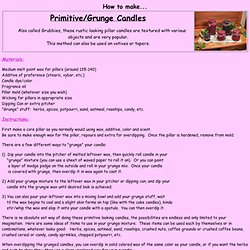
Materials: Medium melt point wax for pillars (around 135-140)Additive of preference (stearic, vybar, etc.)Candle dye/colorFragrance oilPillar mold (whatever size you wish)Wicking for pillars in appropriate sizeDipping Can or extra pitcher"Grunge" stuff: herbs, spices, potpourri, sand, oatmeal, rosehips, candy, etc. Instructions: First make a core pillar as you normally would using wax, additive, color and scent.Be sure to make enough wax for the pillar, repours and extra for overdipping. Once the pillar is hardened, remove from mold. There are a few different ways to "grunge" your candle: 1) Dip your candle into the pitcher of melted leftover wax, then quickly roll candle in your "grunge" mixture (you can use a sheet of waxed paper to roll it on). 2) Add your grunge mixture to the leftover wax in your pitcher or dipping can, and dip your candle into the grungie wax until desired look is achieved.
Wholesale Candle Making Supplies, Soap Making Supplies, Cosmetic Supplies, Fragrance Oils Natures Garden. How to Make Primitive Candles. Candle Making Supplies - Wax - Fragrance Oils. How to Make Candles - How to Make Soap - Soap Making - Candle Making - Handmade Candles - Homemade Soap. How to Tan a Hide. After hunting or processing livestock for the table, it's a shame to have to toss out a nice pelt.
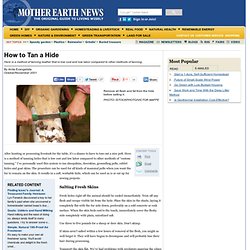
Here is a method of tanning hides that is low cost and low labor compared to other methods of “custom tanning.” I've personally used this system to tan sheepskins, deerskins, groundhog pelts, rabbit hides and goat skins. The procedure can be used for all kinds of mammal pelts when you want the fur to remain on the skin. It results in a soft, workable hide, which can be used as is or cut up for sewing projects. Salting Fresh Skins Fresh hides right off the animal should be cooled immediately. Use three to five pounds for a sheep or deer skin. If skins aren't salted within a few hours of removal of the flesh, you might as well forget it.
Transport the skin flat. Tanning Recipe. Buckskin (leather) BraintanBuckskin.com: Wet-Scrape and Dry-Scrape Hide Tanning Books, Videos, and Tools, plus Braintanning Tips and Trouble-Shooting. How to Make a Buckskin Shirt. How to Tan a Hide: 9 steps. Soap Making Recipes and Tutorials. KandleKaz Western Australia. Soap. A collection of decorative soaps, often found in hotels Two equivalent images of the chemical structure of sodium stearate, a typical soap.
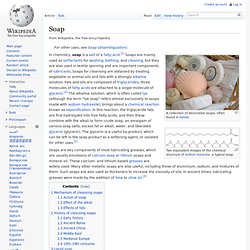
Mechanism of cleansing soaps[edit] Simply Natural Soap Making Supplies - * Make Natural Handmade Soap * Melt and Pour Soap Base. How to tan small hides. How to Make Buckskin Clothes. Native Americans and other cultures around the world have utilised the hides of animals for their clothing for thousands of years.

But taking the hide off a dead animal and making it into soft, supple clothing that has the ability to last for hundreds of years is a true art, and is no simple task. Clothing made of buckskin is luxurious and outrageously expensive--rightfully so, as the steps to make this wearable art are complex and take a lot of work. This article will give you the most basic steps involved in creating buckskin clothing. Skill level: Moderately Challenging Things you need Deer hide Awl Sinew or thread Beads and other decorative material Dyes Shears Show MoreHide Instructions. Butchering / tanning. Making Buckskin. Introduction Making buckskin from a raw deer hide is not difficult.
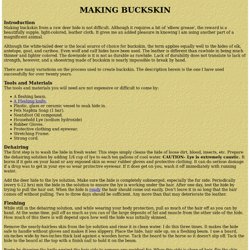
Although it requires a bit of 'elbow grease', the reward is a beautifully supple, light-colored, leather cloth. It gives me an added pleasure in knowing I am using another part of a magnificent animal. Although the white-tailed deer is the local source of choice for buckskin, the term applies equally well to the hides of elk, antelope, goat, and caribou. Even wolf and calf hides have been used. The leather is different than rawhide in being much thinner and lighter colored. There are many variations on the process used to create buckskin. Tools and Materials The tools and materials you will need are not expensive or difficult to come by: A fleshing beam.
Dehairing The first step is to wash the hide in fresh water. Add the deer hide to the lye solution. Fleshing While still in the dehairing solution, and while wearing your body protection, pull as much of the hair off as you can by hand. Tanning. Two men pressing the leather near the end of the tanning process in an American tannery. circa: 1976 Tanning is the process of treating skins of animals to produce leather, which is more durable and less susceptible to decomposition.

Traditionally, tanning used tannin, an acidic chemical compound from which the tanning process draws its name (tannin is in turn named after an old German word for oak or fir trees, from which the compound was derived). Coloring may occur during tanning. A tannery is the term for a place where the skins are processed. History[edit] Tanned rabbit pelt, the fur has been left on apart from small patches exposing leather Once the hair was removed, the tanners would "bate" (soften) the material by pounding dung into the skin, or soaking the skin in a solution of animal brains.
This combination of urine, animal feces and decaying flesh is what made ancient tanneries so malodorous. Children employed as dung gatherers were a common sight in ancient cities. Curing[edit] How to Make Buckskin Clothes.